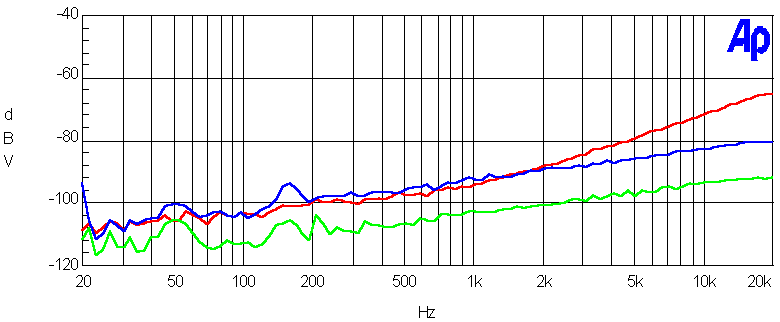

BC550C VCA 1

A VCA built with discrete transistors. The
circuit is taken from René Schmitz'
web site. The transistors were matched acording to the
instructions in the Moog Modular service manual. This simple
circuit does indeed work, but it has a couple of serious
problems.
To start with, it is very temperature sensitive. The DC offset
will go up if the transistors are not at the same temperature.
They definitely need to be thermally coupled. But even with a
constant temperature the CV bleedthrough is too high.
Noise and distortion figures are not better than for OTA-based
VCAs. Signal bleedthrough is low, especially at high frequencies,
but the LM13600 has even lower signal bleedthrough.
The reason for the fairly low signal-to-noise figures is that the
op-amp contributes to the noise. In this circuit it has a gain of
17 times, which adds noise. Thanks to Jürgen Haible
for pointing this out. René Schmitz
had specified a 5534 op-amp, which should be a little less noisy
than the TL071 that I used.
Noise & signal attenuation
Red = signal bleedthtrough at 0V CV. Blue = 10V CV, no signal. Green = 0V CV, no signal.

Distortion (THD+N) vs. input level

Frequency response

Test results
| Dynamic range | 10 V CV, no signal | 83 dBr A |
| 0 V CV, no signal | 95 dBr A | |
| 0 V CV, 1kHz 10 V p-p in | 95 dBr A | |
| 0 V CV, 2 kHz 10 V p-pin | 93 dBr A | |
| 0 V CV, 10 kHz 10 V p-pin | 81 dBr A | |
| Headroom (over 10V p-p) | -4 dB | |
| CV bleedthrough | with careful trimming | 200 mV |
Summary
In contrast to what some people seems to think, a simple discrete circuit like this has no advantages over an OTA-based one.
+
• Low signal bleedthrough
–
• High CV bleedthrough
• Too much distortion at 10 V p-p
• Temperature sensitive
• Needs matched transistors